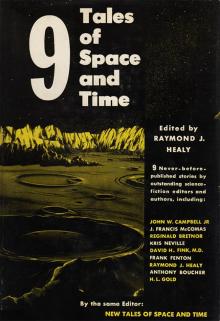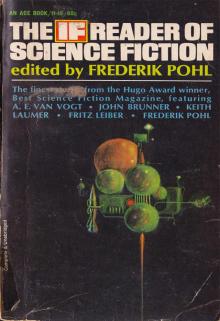Nova 3 Read online
Page 11
Dr. Norbert Denhouter
Director: Midwest Institute for Advanced Studies
Iowa City, Iowa 52240
Dear Norbert:
I have your letter asking my estimate of Dr. Todd Macomber. From your tone, I infer you have her academic and professional record in hand, and that what you want from me is a more personal evaluation. I presume also that my reply will not be circulated, but will go into your private files. You ask for candor. I am delighted to reply.
Before I proceed, I should point out that although she was once a student of mine, there has been no direct contact between us for many years; that it was from Pasadena, not here in Bloomington, that she received her degree. I am led to suspect—perhaps incorrectly—your request was motivated by the fact that she left Bloomington after only one year.
I can assure you, her work was most satisfactory. Vividly, though it was all of seventeen years ago, I remember her quick intelligence, her clear understanding of everything I taught, and her firm independence. Advice she would accept, and judgments she would listen to, but she would make her own conclusions, and decisions were her own.
It was I who suggested that she apply to Pasadena. I also endorsed her application and helped to arrange the financial assistance which made it possible for her. In all these things, I was persuaded by the superior quality of instruction available there, and the prestige which a degree from that school would bestow. I believed, and still believe, it would further her career. I was proud of her, though I had little enough reason to feel pride.
About her private life I know practically nothing. Now she would be in her late thirties. She is a member of the Physics Department in Evanston, where she has been ever since her return from two years of postdoctoral study abroad. I am not sure, but according to my most recent information she holds the rank of Associate Professor. I am also informed that, although she is not presently married, she has a daughter who would now be in her midteens. Discretion has always prevented me from inquiring more deeply, though inevitably gossip has circulated. I have not myself seen the child. I would suggest you ignore the matter.
I have sometimes suspected that because of such extraneous factors, plus the fact that she is a woman in a profession dominated by men—many of whom, I regret to say, seem jealous of their positions—she has sometimes been passed over for promotion, and that for the same reasons she has been omitted from consideration for positions at more prestigious institutions such as your own. I am not otherwise able to explain why she has remained in Evanston—forced by lack of modem equipment to devote almost all her efforts to theoretical studies. Nevertheless, among those of us familiar with her work, she is widely respected. Frequently, she is invited to take part in discussions at neighboring universities.
However, you have asked for my personal judgment. I shall give you something better than that, for her ability can be comprehended most effectively by thinking upon an event from one of the few occasions since her days in Bloomington when I and Dr. Macomber have been in the same room. It was much talked about by those of us who are active in research, though even now Dr. Macomber’s role is not widely known. Usually, it is spoken of as the time Morris Fabricant threw his chalk on the floor.
Even isolated by the administrative demands of your Institute, you may have heard mention of it. You may even remember the circumstances, although I’m not sure how well you keep up with the literature these days. It was the summer before last. That spring, Dr. Fabricant had reported in Physical Review Letters his series of experiments with Californium 247, and his startling conclusion that nuclei of this isotope could be divided into two distinct types, and that these types displayed separate and different rates of decay. He believed that he had developed techniques by which it was possible to differentiate between them, although they seemed otherwise identical.
You may remember, also, that he toured the country, visiting all the important departments to talk about his discovery. I believe he even went to Copenhagen. He did this as a challenge. He was that confident his work was free of error.
Of course, we were all anxious to subject his findings to ruthless and exhaustive criticism, for—had he been correct—it would have meant a fantastic breakthrough in our understanding of the process of nuclear decay. We wanted him to be right, of course, but—even more—we wanted to be absolutely sure he was right. That is the way scientific work is done. Had he been right, he would almost certainly have been in line to receive the Nobel Prize.
When he came to Chicago, I was among those asked up from Bloomington, and Dr. Macomber was invited down from Evanston. I did not know it when the meeting began, or I might have spoken to her. There were a lot of us there. The auditorium was crowded, and I did not see her. At the conclusion of Dr. Fabricant’s presentation, every objection and argument we could imagine was thrown at him. Dr. Fab-ricant filled the blackboard with his equations and formulae and theoretical models, and he demolished every point that was raised. He is, as you know, a brilliant man. He made us seem like fools.
Dr. Macomber’s contribution is not credited in the transcript. However, having been there, I know it was she who asked what became, as it turned out, the final question. Nor were her exact words recorded. According to the published transcript, the tape at this point was indistinct. I consider these omissions unfortunate. I sometimes suspect they were not accidental.
Dr. Fabricant replied at some length and . . . I must say it was very strange. No one said a word. It was something all of us realized at the same moment.
This much is clear in my recollection. Together, Dr. Macomber’s question and the reply Dr. Fabricant gave, made it instantly evident that what Dr. Fabricant had thought was a characteristic by which his two types of nuclei could be identified was actually nothing more than the presence or absence of a previously unsuspected aspect of the excited state of a nucleus in the transitionary period immediately before emission of a decay particle. It was natural, of course, that the excited nuclei would decay more quickly. Once Dr. Macomber brought our attention to the matter, it was obvious. It had not been obvious before.
That was the moment when Dr. Fabricant threw his chalk on the floor. It shattered. He walked out of the room. I presume he went directly back to Berkeley, but that is something I do not know.
I cannot emphasize adequately that nothing about this incident should reflect to Dr. Fabricant’s discredit. His ability is universally recognized, nor do I call it into question now. We have all made similar mistakes at one time or another, and in this case we were all equally deceived. All of us, that is, but Dr. Macomber. It is a measure of her own compe-tance that she perceived the error that had slipped past even the best of us.
Dr. Macomber is a brilliant woman. I recommend her to you highly and without reservation. She would be an excellent addition to the staff of your Institute.
Annemarie joins me in wishing you all of the best. Please remember me to the beautiful Janis, and to your wonderful children. Four, is it now? How I envy you.
Most Cordially yours,
Charles Latourette
PS: Nobby—a personal favor please. As I say, I’ve had no direct contact with Dr. Macomber for many years. I’m hoping you will find it possible to offer the opportunities your Institute can provide, and which she has long deserved. If that can be done, it is likely you will encounter her daughter at some time or another. I would be grateful—call it an old man’s whim—if you could let me know should you notice any perceptible resemblance to me, however slight. A photograph, if possible, would be most welcome. Please give Dr. Macomber my warmest personal regards.
C. L.
THE NATIONAL PASTIME
By NORMAN SPINRAD
Do you like to watch football on the box? We all like to watch football on the box. But it will never be the same again after you read here what we have been missing.
THE FOUNDING FATHER
I KNOW YOU’VE got to start at the bottom in the television business, but produ
cing sports shows is my idea of cruel and unusual punishment. Sometime in the dim past, I had the idea that I wanted to make films, and the way to get to make films seemed to be to run up enough producing and directing credits on television, and the way to do that was to take whatever came along, and what came along was an offer to do a series of sports specials on things like kendo, sumo wrestling, jousting, Thai boxing, in short, ritual violence. This was at the height (or the depth) of the antiviolence hysteria, when you couldn’t so much as show the bad guy getting an on-camera rap in the mouth from the good guy on a moron western. The only way you could give the folks what they really wanted was in the All-American wholesome package of a sporting event. Knowing this up front—unlike the jerks who warm chairs as network executives—I had no trouble producing the kind of sports specials the network executives knew people wanted to see without quite knowing why, and thus I achieved the status of boy genius. Which, alas, ended up in my being offered a long-term contract as a producer in the sports department that was simply too rich for me to pass up, I mean I make no bones about being a crass materialist.
So try to imagine my feelings when Herb Dieter, the network sports programming director, calls me in to his inner sanctum and gives me The Word. “Ed,” he tells me, “as you know, there’s now only one major football league, and the opposition has us frozen out of the picture with long-term contracts with the NFL. As you also know, the major league football games are clobbering us in the Sunday afternoon ratings, which is prime time as far as sports programming is concerned. And as you know, a sports programming director who can’t hold a decent piece of the Sunday afternoon audience is not long for this fancy office. And as you know, there is no sport on God’s green earth that can compete with major league football. Therefore, it would appear that I have been presented with an insoluble problem.
“Therefore, since you are the official boy genius of the sports department, Ed, I’ve decided that you must be the solution to my problem. If I don’t come up with something that will hold its own against pro football by the beginning of next season, my head will roll. Therefore, I’ve decided to give you the ball and let you run with it. Within ninety days, you will have come up with a solution or the fine print boys will be instructed to find a way for me to break your contract.”
I found it very hard to care one way or the other. On the one hand, I liked the bread I was knocking down, but on the other, the job was a real drag and it would probably do me good to get my ass fired. Of course the whole thing was unfair from my point of view, but who could fault Dieter’s logic, he personally had nothing to lose by ordering his best creative talent to produce a miracle or be fired. Unless I came through, he would be fired, and then what would he care about gutting the sports department, it wouldn’t be his baby anymore. It wasn’t very nice, but it was the name of the game we were playing.
“You mean all I’m supposed to do is invent a better sport than football in ninety days, Herb, or do you mean something more impossible?” I couldn’t decide whether I was trying to be funny or not.
But Dieter suddenly had a 20-watt bulb come on behind his eyes (about as bright as he could get). “I do believe you’ve hit on it already, Ed,” he said. “We can’t get any pro football, so you’re right, you’ve got to invent a sport that will outdraw pro football. Ninety days, Ed. And don’t take it too hard; if you bomb out, we’ll see each other at the unemployment office.”
So there I was, wherever that was. I could easily get Dieter to do for me what I didn’t have the willpower to do for myself and get me out of the stinking sports department—all I had to do was not invent a game that would outdraw pro football. On the other hand, I liked living the way I did, and I didn’t like the idea of losing anything because of failure.
So the next Sunday afternoon, I eased out the night before’s chick, turned on the football game, smoked two joints of Acapulco Gold and consulted my muse. It was the ideal set of conditions for a creative mood: I was being challenged, but if I failed, I gained too, so I had no inhibitions on my creativity. I was stoned to the point where the whole situation was a game without serious consequences; I was hanging loose.
Watching two football teams pushing each other back and forth across my color television screen, it once again occurred to me how much football was a ritual sublimation of war. This seemed perfectly healthy. Lots of cultures are addicted to sports that are sublimations of the natural human urge to clobber people. Better the sublimation than the clobbering. People dig violence, whether anyone likes the truth or not, so it’s a public service to keep it on the level of a spectator sport.
Hmmm . . . that was probably why pro football had replaced baseball as the National Pastime in a time when people, having had their noses well rubbed in the stupidity of war, needed a war substitute. How could you beat something that got the American armpit as close to the gut as that?
And then from the blue grass mountaintops of Mexico, the flash hit me: the only way to beat football was at it’s own game! Start with football itself, and convert it into something that was an even closer metaphor for war, something that could be called—
!!COMBAT FOOTBALL!!
Yeah, yeah, Combat Football, or better, COMBAT football. Two standard football teams, standard football field, standard football rules, except:
Take off all their pads and helmets and jerseys and make it a warm-weather game that they play in shorts and sneakers like boxing. More meaningful, more intimate violence. Violence is what sells football, so give ’em a bit more violence than football, and you’ll draw a bit more than football. The more violent you can make it and get away with it, the better you’ll draw.
Yeah . . . and you could get away with punching, after all boxers belt each other around and they still allow boxing on television; sports have too much All American Clean for the anti violence freaks to attack, in fact, where their heads are at, they’d dig Combat Football. Okay. So in ordinary football, the defensive team tackles the ball carrier to bring him to his knees and stop the play. So in Combat, the defenders can slug the ball carrier, kick him, tackle him, why not, anything to bring him to his knees and stop the play. And to make things fair, the ball carrier can slug the defenders to get them out of his way. If the defense slugs an offensive player who doesn’t have possession, it’s ten yards and an automatic first down. If anyone but the ball carrier slugs a defender, it’s ten yards and a loss of down.
Presto: Combat Football!
And the final touch was that it was a game that any beer-sodden moron who watched football could learn to understand in sixty seconds, and any lout who dug football would have to like Combat better.
The boy genius had done it again! It even made sense after I came down.
Farewell to the Giants
Jeez, I saw a thing on television last Sunday you wouldn’t believe. You really oughta watch it next week, I don’t care who the Jets or the Giants are playing. I turned on the TV to watch the Giants game and went to get a beer, and when I came back from the kitchen I had some guy yelling something about today’s professional combat football game, and it’s not the NFL announcer, and it’s a team called the New York Sharks playing a team called the Chicago Thunderbolts, and they’re playing in L.A. or Miami, I didn’t catch which, but someplace with palm trees anyway, and all the players are bare-ass! Well, not really bare-ass, but all they’ve got on is sneakers and boxing shorts with numbers across the behind—blue for New York, green for Chicago. No helmets, no pads, no protectors, no jerseys, no nothing!
I check the set and sure enough I’ve got the wrong channel. But I figured I could turn on the Giants game anytime, what the hell, you can see the Giants all the time, but what in hell is this?
New York kicks off to Chicago. The Chicago kick-returner gets the ball on about the 10—bad kick—and starts upfield. The first New York tackier reaches him and goes for him and the Chicago player just belts him in the mouth and runs by him! I mean, with the ref standing there watching it, and
no flag thrown! Two more tacklers come at him on the 20. One dives at his legs, the other socks him in the gut. He trips and staggers out of the tackle, shoves another tackier away with a punch in the chest, but he’s slowed up enough so that three or four New York players get to him at once. A couple of them grab his legs to stop his motion, and the others knock him down, at about the 25. Man, what’s going on here?
I check my watch. By this time the Giants game has probably started, but New York and Chicago are lined up for the snap on the 25, so I figure what the hell, I gotta see some more of this thing, so at least I’ll watch one series of downs.
On first down, the Chicago quarterback drops back and throws a long one way downfield to his flanker on maybe the New York 45; it looks good, there’s only one player on the Chicago flanker, he beats this one man and catches it, and it’s a touchdown, and the pass looks right on the button. Up goes the Chicago flanker, the ball touches his hands—and pow, right in the kisser! The New York defender belts him in the mouth and he drops the pass. Jeez, what a game!
Second and ten. The Chicago quarterback fades back, but it’s a fake, he hands off to his fullback, a gorilla who looks like he weighs about two-fifty, and the Chicago line opens up a little hole at left tackle and the fullback hits it holding the ball with one hand and punching with the other. He belts out a tackier, takes a couple of shots in the gut, slugs a second tackier, and then someone has him around the ankles; he drags himself forward another half yard or so, and then he runs into a good solid punch and he’s down on the 28 for a three-yard gain.
Man, I mean action! What a game! Makes the NFL football look like something for faggots! Third and seven, you gotta figure Chicago for the pass, right? Well on the snap, the Chicago quarterback just backs up a few steps and pitches a short one to his flanker at about the line of scrimmage. The blitz is on and everyone comes rushing in on the quarterback and before New York knows what’s happening, the Chicago flanker is five yards downfield along the left sideline and picking up speed. Two New York tacklers angle out to stop him at maybe the Chicago 40, but he’s got up momentum and one of the New York defenders runs right into his fist—I could hear the thud even on television—and falls back right into the other New York player, and the Chicago flanker is by them, the 40, the 45, he angles back toward the center of the field at midfield, dancing away from one more tackle, then on maybe the New York 45 a real fast New York defensive back catches up to him from behind, tackles him waist-high, and the Chicago flanker’s motion is stopped as two more tacklers come at him. But he squirms around inside the tackle and belts the tackier in the mouth with his free hand, knocks the New York back silly, breaks the tackle, and he’s off again downfield with two guys chasing him—40, 35, 30, 25, he’s running away from them. Then from way over the right side of the field, I see the New York safety man running flat out across the field at the ball carrier, angling toward him so it looks like they’ll crash like a couple of locomotives on about the 15, because the Chicago runner just doesn’t see this guy. Ka-boom! The ball carrier running flat out runs right into the fist of the flat out safety at the 15 and he’s knocked about ten feet one way and the football flys ten feet the other way, and the New York safety scoops it up on the 13 and starts upfield, 20, 25, 30, 35, and then slam, bang, whang, half the Chicago team is all over him, a couple of tackles, a few in the gut, a shot in the head, and he’s down. First and ten for New York on their own 37. And that’s just the first series of downs!

![[What Might Have Been 02] Alternate Heroes Read online](http://i1.bookreadfree.com/27/what_might_have_been_02_alternate_heroes_preview.jpg) [What Might Have Been 02] Alternate Heroes
[What Might Have Been 02] Alternate Heroes![[What Might Have Been 01] Alternate Empires Read online](http://i1.bookreadfree.com/01/what_might_have_been_01_alternate_empires_preview.jpg) [What Might Have Been 01] Alternate Empires
[What Might Have Been 01] Alternate Empires SEDUCTIVE: A Contemporary Romance Anthology
SEDUCTIVE: A Contemporary Romance Anthology A Year of Love
A Year of Love Super Daddies: A Naughty Nerdy Romantic Comedy Anthology
Super Daddies: A Naughty Nerdy Romantic Comedy Anthology Mystical Xmas: Paranormal Romance Anthology Box Set
Mystical Xmas: Paranormal Romance Anthology Box Set![[What Might Have Been 04] Alternate Americas Read online](http://i1.bookreadfree.com/06/what_might_have_been_04_alternate_americas_preview.jpg) [What Might Have Been 04] Alternate Americas
[What Might Have Been 04] Alternate Americas 9 Tales of Space and Time
9 Tales of Space and Time Assignment in Tomorrow
Assignment in Tomorrow![[What Might Have Been 03] Alternate Wars Read online](http://i1.bookreadfree.com/i/03/16/what_might_have_been_03_alternate_wars_preview.jpg) [What Might Have Been 03] Alternate Wars
[What Might Have Been 03] Alternate Wars The Complete Dangerous Visions
The Complete Dangerous Visions The IF Reader of Science Fiction
The IF Reader of Science Fiction Holiday in the Heart
Holiday in the Heart Torquere Press Sips and Shots
Torquere Press Sips and Shots Possess: An Alpha Anthology
Possess: An Alpha Anthology Beyond Control
Beyond Control Bad Boys Under the Mistletoe: A Begging for Bad Boys Collection
Bad Boys Under the Mistletoe: A Begging for Bad Boys Collection Hugo Awards: The Short Stories (Volume 3)
Hugo Awards: The Short Stories (Volume 3) The Second IF Reader of Science Fiction
The Second IF Reader of Science Fiction Astounding Science Fiction Stories Vol 1
Astounding Science Fiction Stories Vol 1 What Happens Over Spring Break: A Short Story Anthology
What Happens Over Spring Break: A Short Story Anthology eSteampunk Vol. 01 No. 02
eSteampunk Vol. 01 No. 02 SHADOWRUN: Spells and Chrome (shadowrun)
SHADOWRUN: Spells and Chrome (shadowrun) Dark Tales
Dark Tales Getting Schooled (Craving #9)
Getting Schooled (Craving #9) The Hellfire Book of Beltane Volume One
The Hellfire Book of Beltane Volume One The Alpha's
The Alpha's The Future Is Short
The Future Is Short From the Heart: A Valentine's Day Anthology
From the Heart: A Valentine's Day Anthology Reckless: A Bad Boyz Anthology
Reckless: A Bad Boyz Anthology LOL #3 Romantic Comedy Anthology
LOL #3 Romantic Comedy Anthology A Christmas Seduction: A Regency Anthology
A Christmas Seduction: A Regency Anthology All a Cowboy Wants for Christmas
All a Cowboy Wants for Christmas Hugo Awards: The Short Stories (Volume 2)
Hugo Awards: The Short Stories (Volume 2) The Golden Age of Science Fiction Novels Vol 01
The Golden Age of Science Fiction Novels Vol 01 The Sirens of SaSS Anthology
The Sirens of SaSS Anthology Mistletoe & Kisses
Mistletoe & Kisses Explorers of Space
Explorers of Space Time Travel Omnibus Volume 2
Time Travel Omnibus Volume 2 Dead Science: A Zombie Anthology
Dead Science: A Zombie Anthology Beer Goggles Anthology
Beer Goggles Anthology Apexology: Horror
Apexology: Horror Heat Wave: A Summer Loving Anthology
Heat Wave: A Summer Loving Anthology Fall in Love
Fall in Love Love Under the Mistletoe
Love Under the Mistletoe Hook & Ladder 69: Eighteen Authors...One Sexy Firehouse.
Hook & Ladder 69: Eighteen Authors...One Sexy Firehouse. LOL #2 Romantic Comedy Anthology - Volume 2 - Even More All-New Romance Stories by Bestselling Authors (LOL Romantic Comedy Anthology #2)
LOL #2 Romantic Comedy Anthology - Volume 2 - Even More All-New Romance Stories by Bestselling Authors (LOL Romantic Comedy Anthology #2) Off the Beaten Path: Eight Tales of the Paranormal
Off the Beaten Path: Eight Tales of the Paranormal![Best New Zombie [3] - Best New Zombie Tales, Vol. 3 Read online](http://i1.bookreadfree.com/i/03/25/best_new_zombie_3_-_best_new_zombie_tales_vol_3_preview.jpg) Best New Zombie [3] - Best New Zombie Tales, Vol. 3
Best New Zombie [3] - Best New Zombie Tales, Vol. 3 The Golden Age of Science Fiction Novels Vol 05
The Golden Age of Science Fiction Novels Vol 05 Alphas of Sin
Alphas of Sin Halloween Spirits: 11 Tales for the Darkest Night
Halloween Spirits: 11 Tales for the Darkest Night Night Shift 2
Night Shift 2 Ellora's Cavemen: Jewels of the Nile II
Ellora's Cavemen: Jewels of the Nile II Hot for the Holidays (21 Holiday Short Stories): A Collection of Naughty and Nice Holiday Romances
Hot for the Holidays (21 Holiday Short Stories): A Collection of Naughty and Nice Holiday Romances Of Heaven and Hell
Of Heaven and Hell 12 Christmas Romances To Melt Your Heart
12 Christmas Romances To Melt Your Heart '90s Playlist (Romance Rewind #1)
'90s Playlist (Romance Rewind #1) Bleed Blue 69: Twenty-Five Authors…One Sexy Police Station
Bleed Blue 69: Twenty-Five Authors…One Sexy Police Station The Cthulhu Mythos Megapack (40 Modern and Classic Lovecraftian Tales)
The Cthulhu Mythos Megapack (40 Modern and Classic Lovecraftian Tales) Nova 3
Nova 3 Unbroken: 13 Stories Starring Disabled Teens
Unbroken: 13 Stories Starring Disabled Teens Dead Men (and Women) Walking
Dead Men (and Women) Walking Sweet Seduction
Sweet Seduction Brothel: The Magnolia Diaries
Brothel: The Magnolia Diaries Rogues (A Boys Behaving Badly Anthology #1)
Rogues (A Boys Behaving Badly Anthology #1) Best New Zombie Tales, Vol. 3
Best New Zombie Tales, Vol. 3![The Hellfire Bo [1] - The Hellfire Book of Beltane Volume One Read online](http://i1.bookreadfree.com/i1/04/06/the_hellfire_bo_1_-_the_hellfire_book_of_beltane_volume_one_preview.jpg) The Hellfire Bo [1] - The Hellfire Book of Beltane Volume One
The Hellfire Bo [1] - The Hellfire Book of Beltane Volume One Horror in Paradise
Horror in Paradise Time Travel Omnibus Volume 1
Time Travel Omnibus Volume 1 More Than Words: Stories of Courage
More Than Words: Stories of Courage River Walk: Ten Kinky Collaborations
River Walk: Ten Kinky Collaborations F*cking Awkward
F*cking Awkward Hearts of England
Hearts of England The Golden Age of Science Fiction Novels Vol 03
The Golden Age of Science Fiction Novels Vol 03 Drunk in Love
Drunk in Love Up and Coming: Stories by the 2016 Campbell-Eligible Authors
Up and Coming: Stories by the 2016 Campbell-Eligible Authors Descended from Darkness: Apex Magazine Vol I
Descended from Darkness: Apex Magazine Vol I Dominant Persuasions Anthology: 12 Tales of D/s, Where Mastery Meets Passion
Dominant Persuasions Anthology: 12 Tales of D/s, Where Mastery Meets Passion The Golden Age of Science Fiction Novels Vol 04
The Golden Age of Science Fiction Novels Vol 04 Passion in Portland 2016 Anthology
Passion in Portland 2016 Anthology Men of Mayhem
Men of Mayhem The Dirty Anthology
The Dirty Anthology Hot For Teacher
Hot For Teacher Nova 2
Nova 2 eSteampunk Vol. 01 No. 03
eSteampunk Vol. 01 No. 03 Afternoon Tea Mysteries Vol Three
Afternoon Tea Mysteries Vol Three Romance in the Rain
Romance in the Rain Tales From the Crossroad Volume 1
Tales From the Crossroad Volume 1 A Very Alpha Christmas
A Very Alpha Christmas Nova 1
Nova 1 Once: A Collection of Sinfully Sexy and Twisted Tales
Once: A Collection of Sinfully Sexy and Twisted Tales Nuts About You: A Testicular Cancer Anthology
Nuts About You: A Testicular Cancer Anthology From the Street (shadowrun stories)
From the Street (shadowrun stories) Box of 1Night Stands: 21 Sizzling Nights
Box of 1Night Stands: 21 Sizzling Nights Descended from Darkness: Vol II
Descended from Darkness: Vol II Pink Shades of Words: Walk 2016
Pink Shades of Words: Walk 2016 The Art of Taking Chances
The Art of Taking Chances The Butterfly Box_A SASS Anthology
The Butterfly Box_A SASS Anthology Harlan County Horrors
Harlan County Horrors![Afternoon Tea Mysteries [Vol Three] Read online](http://i1.bookreadfree.com/i2/04/12/afternoon_tea_mysteries_vol_three_preview.jpg) Afternoon Tea Mysteries [Vol Three]
Afternoon Tea Mysteries [Vol Three] The Golden Age of Science Fiction Novels Vol 02
The Golden Age of Science Fiction Novels Vol 02 Ellora's Cavemen: Jewels of the Nile III
Ellora's Cavemen: Jewels of the Nile III